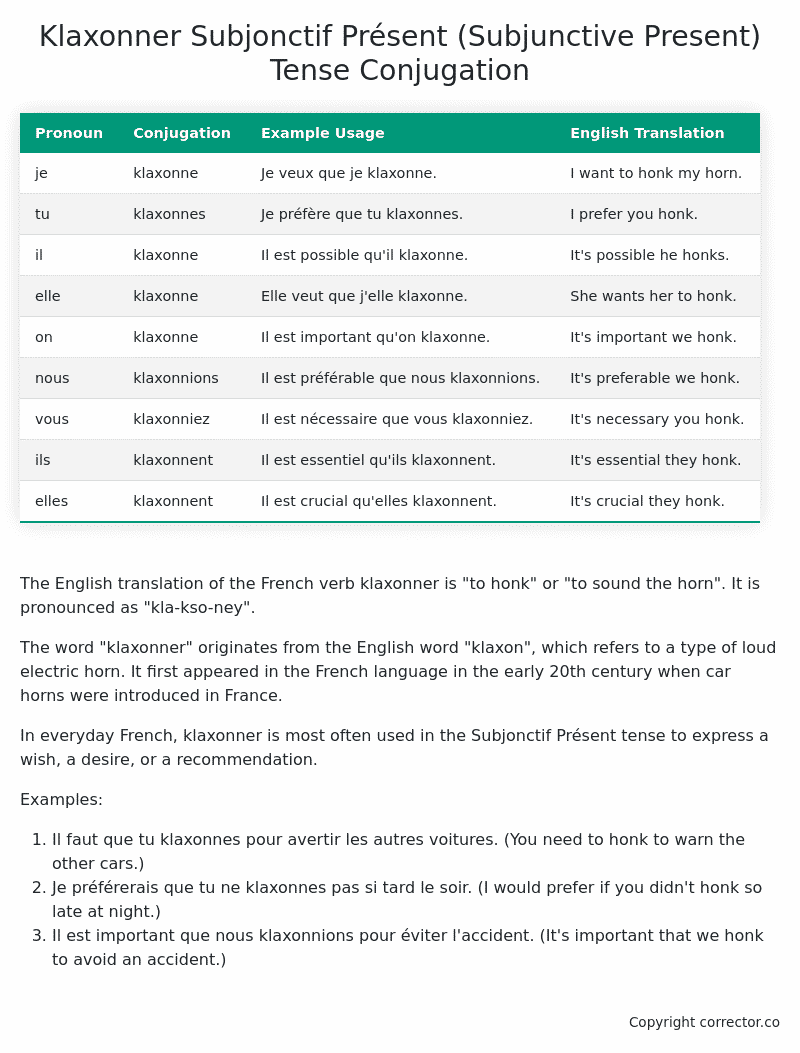Subjonctif Présent (Subjunctive Present) Tense Conjugation of the French Verb klaxonner
Introduction to the verb klaxonner
The English translation of the French verb klaxonner is “to honk” or “to sound the horn”. It is pronounced as “kla-kso-ney”.
The word “klaxonner” originates from the English word “klaxon”, which refers to a type of loud electric horn. It first appeared in the French language in the early 20th century when car horns were introduced in France.
In everyday French, klaxonner is most often used in the Subjonctif Présent tense to express a wish, a desire, or a recommendation.
Examples:
- Il faut que tu klaxonnes pour avertir les autres voitures. (You need to honk to warn the other cars.)
- Je préférerais que tu ne klaxonnes pas si tard le soir. (I would prefer if you didn’t honk so late at night.)
- Il est important que nous klaxonnions pour éviter l’accident. (It’s important that we honk to avoid an accident.)
Table of the Subjonctif Présent (Subjunctive Present) Tense Conjugation of klaxonner
| Pronoun | Conjugation | Example Usage | English Translation |
|---|---|---|---|
| je | klaxonne | Je veux que je klaxonne. | I want to honk my horn. |
| tu | klaxonnes | Je préfère que tu klaxonnes. | I prefer you honk. |
| il | klaxonne | Il est possible qu’il klaxonne. | It’s possible he honks. |
| elle | klaxonne | Elle veut que j’elle klaxonne. | She wants her to honk. |
| on | klaxonne | Il est important qu’on klaxonne. | It’s important we honk. |
| nous | klaxonnions | Il est préférable que nous klaxonnions. | It’s preferable we honk. |
| vous | klaxonniez | Il est nécessaire que vous klaxonniez. | It’s necessary you honk. |
| ils | klaxonnent | Il est essentiel qu’ils klaxonnent. | It’s essential they honk. |
| elles | klaxonnent | Il est crucial qu’elles klaxonnent. | It’s crucial they honk. |
Other Conjugations for Klaxonner.
Le Present (Present Tense) Conjugation of the French Verb klaxonner
Imparfait (Imperfect) Tense Conjugation of the French Verb klaxonner
Passé Simple (Simple Past) Tense Conjugation of the French Verb klaxonner
Passé Composé (Present Perfect) Tense Conjugation of the French Verb klaxonner
Futur Simple (Simple Future) Tense Conjugation of the French Verb klaxonner
Futur Proche (Near Future) Tense Conjugation of the French Verb klaxonner
Plus-que-parfait (Pluperfect) Tense Conjugation of the French Verb klaxonner
Passé Antérieur (Past Anterior) Tense Conjugation of the French Verb klaxonner
Futur Antérieur (Future Anterior) Tense Conjugation of the French Verb klaxonner
Subjonctif Présent (Subjunctive Present) Tense Conjugation of the French Verb klaxonner (this article)
Subjonctif Passé (Subjunctive Past) Tense Conjugation of the French Verb klaxonner
Subjonctif Imparfait (Subjunctive Imperfect) Tense Conjugation of the French Verb klaxonner
Subjonctif Plus-que-parfait (Subjunctive Pluperfect) Tense Conjugation of the French Verb klaxonner
Conditionnel Présent (Conditional Present) Tense Conjugation of the French Verb klaxonner
Conditionnel Passé (Conditional Past) Tense Conjugation of the French Verb klaxonner
L’impératif Présent (Imperative Present) Tense Conjugation of the French Verb klaxonner
L’infinitif Présent (Infinitive Present) Tense Conjugation of the French Verb klaxonner
Struggling with French verbs or the language in general? Why not use our free French Grammar Checker – no registration required!
Get a FREE Download Study Sheet of this Conjugation 🔥
Simply right click the image below, click “save image” and get your free reference for the klaxonner Subjonctif Présent tense conjugation!

Klaxonner – About the French Subjonctif Présent (Subjunctive Present) Tense
Formation of the Subjonctif Présent
Common Everyday Usage Patterns
Interactions with Other Tenses
Summary
I hope you enjoyed this article on the verb klaxonner. Still in a learning mood? Check out another TOTALLY random French verb conjugation!


